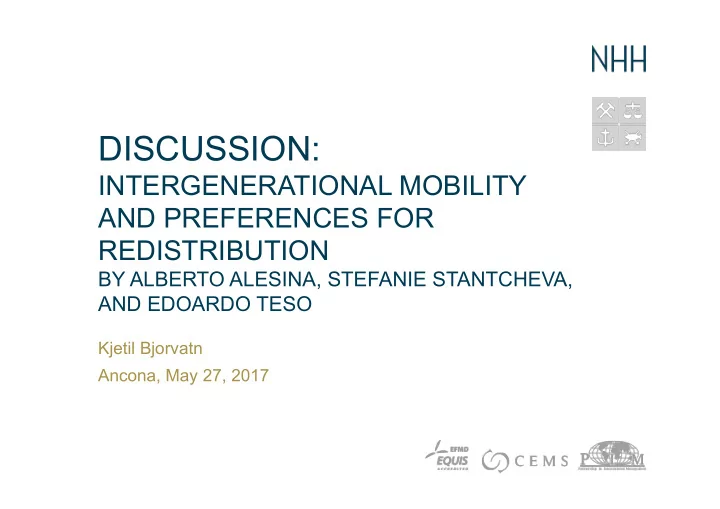

DISCUSSION: INTERGENERATIONAL MOBILITY AND PREFERENCES FOR REDISTRIBUTION BY ALBERTO ALESINA, STEFANIE STANTCHEVA, AND EDOARDO TESO Kjetil Bjorvatn Ancona, May 27, 2017
2
The income ladder Some on top, some lower down... should the ones on the bottom get help? . 3
1. Can’t they climb on their own? (Beliefs) 2. Even if they can’t, is that a problem? (Fairness preferences) 3. Can we really help? (Costs) 4
5
Some striking findings about mobility beliefs • Americans are more optimistic than Europeans about intergenerational mobility. • Americans are too optimistic, and Europeans are too pessimistic, about mobility!! • Optimism in America is particularly high in states where actual mobility is low!!! 6
7
8
The FAIR Vision To conduct groundbreaking experimental research on how to address inequality in society Social Understanding Institutions and The Moral Mind Inequality Moral Which inequalities What are the do we consider Motivation drivers of unfair unfair? What shapes our inequalities? fairness views? FAIR
Almås, Cappelen, Tungodden • Focus on social fairness preferences • Nationally representative samples in US and Norway • Incentivized experiments: workers (2000 pairs) and spectators (2000) • Workers worked on a task; spectators then chose redistribution • Three treatments: 1. Luck : 0 USD or 6 USD, a lottery 2. Merit : 6 USD to more productive worker, 0 USD to less productive 3. Efficiency : As in luck treatment, but costly to redistribute • Spectators had no information about the nationality of workers, but full information about conditions (so no differences in beliefs) • Are fairness preferences different in the US and Norway? 10
11
12
13
14
15
16
Why not more political pressure for redistribution in the US? • Beliefs : The American dream; the poor are “temporarily embarrassed millionaires” (John Steinbeck) • Preferences : Americans think the system is fair; (bad) luck is part of the game • ....but is that the full story? 17
18
Political choice is not only about the economy! • Social values matter too (and gain prominence in time of economic stagnation) • The republican party has championed conservative social policy, and discredit the democratic party as “liberals”, out of touch with “real people” • Working-class (in Kansas and elsewhere) votes Republican for their “values”, even if their policy is pro- rich. A vicious circle? 19
Remaining questions • Why do beliefs differ so widely between the US and Europe? • Why are fairness norms so different? • And why does US choose Trump and protectionism while France chooses Macron and openness? 20
21
Americans and Norwegians • More Americans are libertarians; accept the current situation as fair (there is nothing wrong with the ladder) • More Norwegians are egalitarians; strong wish to eliminate inequality, even when due to productivity 22
Americans versus Europeans: Americans : It’s easy to climb! (The American dream) On the way up, no need for a push. And people who don’t climb, are lazy. Europeans : There is something wrong with the ladder! It is very difficult to climb, even if you try. Luck determines your position, and people should not be held responsible for luck Americans and (some) Europeans : Very costly to help! Trust in government remarkably low in Italy and France; Americans want small government. 23
Mobility beliefs and redistributive preferences • Information treatment, aimed at making respondents’ perceptions of mobility more pessimistic. • Left wing respondents become even more supportive of egalitarian policies • Right wing respondents also change their views bout social mobility but did not want any additional government intervention 24
How difficult do people think it is to help? • Most people think the government has the ability to reduce inequality, but they do not trust the government to do so (trust is remarkably low in Italy and France). • Americans prefer low level of government involvement 25
26
27
Among Norwegian spectators, 80% chose to redistribute the bonus and make it equal between the two workers. Among Americans only 50% chose to share it out. “Americans voted for a candidate that promised to lower taxes for the richest when the country faces historically high levels of inequality. This is surprising from a European perspective, but our study shows that Americans are much more likely than Scandinavians to consider an inequality as fair, even in cases where inequality is caused by brute luck.” MERIT: In this case, Norwegians were much happier to accept the unequal earnings, with only 35% opting to redistribute. Just 15% of Americans wanted to redistribute. • EFFICIENCY: • In this case, the results were the same as under the luck scenario. In other words, a large proportion of Norwegians still wanted to equalise the earnings between the two workers despite that redistribution coming at a cost. So 80% of Norwegians and 50% of Americans still wanted to equalise, said Tungodden. 28
Three fairness views • Egalitarian : Always divide equally (when it’s not too costly) • Libertarian : Let the workers receive their earnings in all treatments (never redistribute) • Meritocratic : Source of inequality important; inequality due to luck is unfair, inequality due to merit is fair. 29
30
• Experiment, full information about source of inequality and about cost or redistribution: isolate fairness preference • Main findings: We show that Americans and Norwegians differ in terms of fairness preferences • But Norwegians too are more willing to accept inequality based on productivity 31
• We show that the source of inequality is essential • for understanding inequality acceptance in both the United States and Norway; in all • subgroups of our samples, we find that the introduction of a difference in productivity • as the source of inequality significantly increases inequality acceptance. We also show • that fairness considerations appear to be much more important for individuals than • efficiency considerations. We believe that these insights shed important light on the • nature of social preferences and what drives attitudes towards redistribution in society. 32
Recommend
More recommend